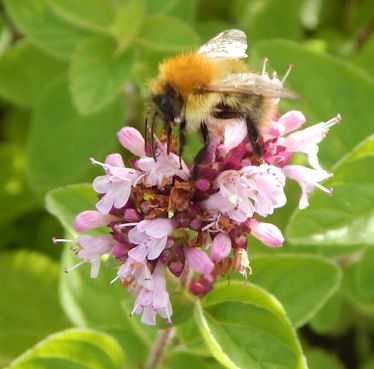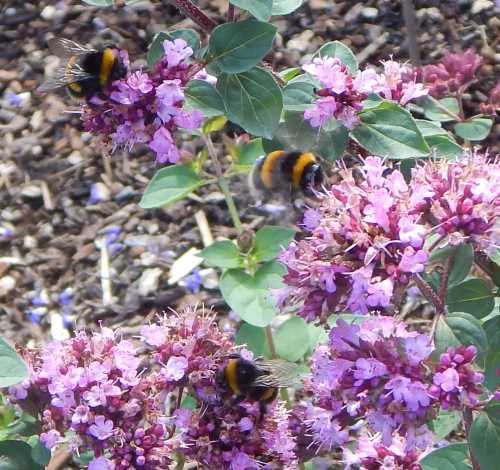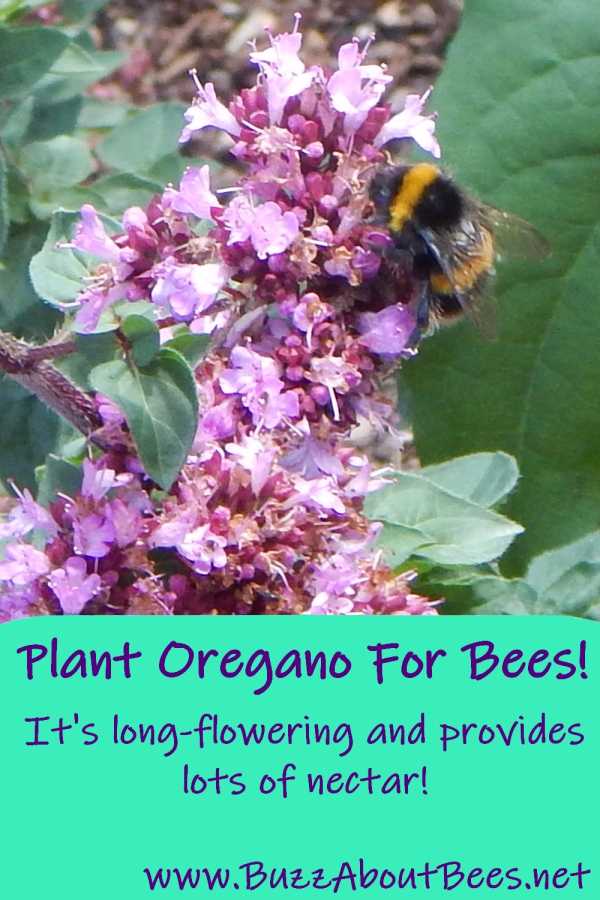Plant Oregano And Marjoram For Bees
Bees love oregano and marjoram (Oreganums). This group of fragrant herbs are irresistible for bees.
At a visit to a beautiful historic garden recently, it was interesting to observe which flowers the bees and butterflies were mostly visiting.
Of course, whether or not a plant is being visited by pollinators has much to do with the stage of the flower (whether it is in the phase of offering maximum reward in terms of nectar and pollen) – and this in turn can be affected by other variables such as the time of day, location of the sun, and the plant’s health.
It also depends on the types of bees and other pollinator species abundant locally, and the other flower types in the vicinity.
 Common carder bumble bee (Bombus pascuorum) on Oreganum vulgare - wild oregano / wild marjoram
Common carder bumble bee (Bombus pascuorum) on Oreganum vulgare - wild oregano / wild marjoramThat said, to see so many bees, butterflies and other pollinators around one plant species when so much else is on offer, really is positive confirmation of its attractiveness, at least for part of its flowering phase.
Which varieties of oregano and marjoram are most attractive for bees?
 Buff-tailed bumble bee (Bombus terrestis) foraging on marjoram - Oreganum Rosenkuppel.
Buff-tailed bumble bee (Bombus terrestis) foraging on marjoram - Oreganum Rosenkuppel.There are plenty of varieties attractive to bees. My favourites are Oreganum vulgare (wild marjoram), and Oreganum Rosenkuppel.
 Honey bees (Apis mellifera) foraging on oregano - Oreganum Rosenkuppel.
Honey bees (Apis mellifera) foraging on oregano - Oreganum Rosenkuppel.
A further species known to be especially popular with bees is Origanum syriacum, (common name, 'Lebanese Oregano' or 'bible hyssop'), although I have no experience of this particular plant.
Which bees visit Oreganos and Marjoram?
One study in Jordan involving 16 small shrubs observed as many as 21 different species of bee visiting Origanum syriacum flowers1 over a period of 42 consecutive days.
Other insect visitors, mostly hymenopterans, were also recorded.
Bees from 4 different families were observed (Apidae, Megachilidae, Andrenidae and Halictidae. Of those that could be identified by the authors of the study, come of the visiting bee species recorded were:
Apidae:
Eucera nigrescens
Nomada succincta
Apis mellifera
Tetralonia salicariae
Tetralonia dentata
Megachilidae:
Anthidium undulatum
Anthidium dentatum
Heriades syriaca
Heriades truncorum
Andrenidae:
Andrena flavipes
Andrena nitida
Halictidae:
Halictus aegypticola
Halictus sexcinctus
Halictus quadricinctus
Lasioglossum calceatum
Lasioglossum lineare
Lasioglossum pauxillum
Why do bees like oregano and marjoram? Why do so many bees visit the flowers?
 Bumble bees foraging on a small patch of Oregano (Marjoram)
Bumble bees foraging on a small patch of Oregano (Marjoram)
There are two main reasons.
- They provide lots of nectar.
- Oregano and marjoram are generally in flower during the height of summer, when colonies are fully in development, meaning there are more hungry bees to feed: mature bees feeding themselves and also foraging to take food back to the young at the nest or hive.
Therefore, bees will be more visible around these plants because it not only offers plenty of reward in the form of nectar, but also because bee populations are at their peak when oregano is at its most attractive to bees.
How to plant oregano /marjoram for bees, butterflies and other pollinators
 Painted lady butterfly - (Vanessa carduion) on Oregano (Marjoram).
Painted lady butterfly - (Vanessa carduion) on Oregano (Marjoram).Plant oregano in a sunny spot. One of the great things about oregano is that it is fairly tolerant of poor quality, dry soils. It can tolerate a certain amount of drought.
You can sow oregano from seed, take cuttings or potentially divide plants in autumn to increase the size of your patch. I like to offer at least 2 patches of popular bee-friendly plants at different locations in the garden, if I can.
Cut back old flower stems in autumn.
How to divide oregano plants
To divide the plant:
- First cut back old flower stems.
- Prepare a place for the new plants to go – remove weeds, dig a space and water well.
- Dig up the whole of the oregano plant, and use couple of forks to divide the plant in two down the centre.
- Replant the sections of plant, ensuring the roots are well covered and the plant is firmly in the soil.
- Once you divide the plant, it may ‘sulk’ for a while, but should eventually recover.
 The small tortoiseshell butterfly (Aglais urticae) was also enjoying the oregano!
The small tortoiseshell butterfly (Aglais urticae) was also enjoying the oregano!Top tip!
Remember, as a double bonus, you can still clip a few of the fragrant leaves to add to your cooking – (this ‘pizza herb’ not only offers flavor, it has anti-oxidant properties too2. Better still, dry the leaves and store them for use later).
Pick the leaves before the flower buds open.
References:
1. Abd Al-Majeed Al-Ghzawi, Shahera Zaitoun, Nawaf Freihat & Ahmad Alqudah (2009) Effect of pollination on seed set of Origanum syriacum under semiarid Mediterranean conditions, Acta Agriculturae Scandinavica, Section B — Soil & Plant Science, 59:3, 273-278, DOI: 10.1080/09064710802093862
2. H. Khanum, K. Ramalakshmi, P. Srinivas and B. Borse, "Synergistic Antioxidant Action of Oregano, Ajowan and Borage Extracts," Food and Nutrition Sciences, Vol. 2 No. 5, 2011, pp. 387-392. doi: 10.4236/fns.2011.25054.
More articles about bees and plants
- Bees And Brambles: The Value Of Brambles To Bees Also known as blackberry bush, research shows each bramble flower secretes lots of nectar for bees!
- Bees And Bee Balm Bee Balm (Monarda) - also known as 'Bergamot) is a herbaceous perennial which is attractive for bees.
- 30 Fantastic Garden Flowers For Bees Flowering plant recommendations for the perfect bee garden.
- Bees love lupins – but so do slugs and snails, so what can you do? Here's a way to protect your lupins....using garlic!
- Plant Oregano For Bees (Marjoram) It's rich in nectar, and attracts bees, butterflies and hoverflies in summer. Here's how to plant it.
- Fennel Pollen And Nectar Bees love fennel! How to grow it, gather it, and the many uses of fennel seeds and pollen.
If you found this page helpful or interesting, I'd really be grateful if you would share it with others - if not this page, perhaps another, such as Gardening For Bees.
Thank you so much :) .

